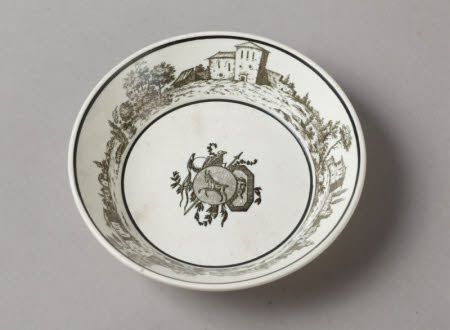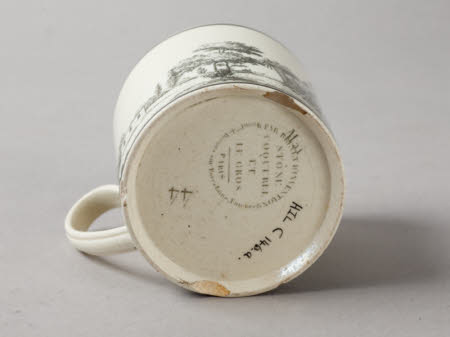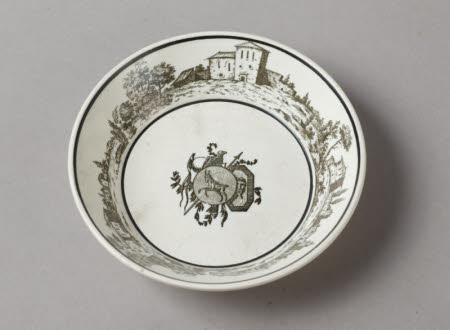Cup
Stone, Coquerel and Le Gros
Category
Ceramics
Date
1810 - 1820
Materials
earthenware transfer printed in black
Measurements
59 mm (Height); 57 mm (Diameter)
Place of origin
Paris
Order this imageCollection
Beatrix Potter Gallery, Cumbria
NT 641511
Summary
Coffee can and saucer, earthenware, straight sided coffee can and saucer with deep flange, made by Creil, decorated by Stone, Coquerel and Legros, Paris, ca 1810-20; the coffee can printed in black with a rural scene with a kneeling woman clutching breast, the saucer with a trophy group at the centre of the well including a central shield with a goat, a rural scene of farm buildings and trees encircling the flange, with a plain band at the rim.
Full description
This coffee can and saucer are from the collection at Hill Top. Beatrix Potter purchased this farmhouse in the Lake District village of Near Sawrey in 1905, using the profits from her books. After her marriage to William Heelis in 1913, Beatrix relocated permanently to Sawrey. The couple made nearby Castle Cottage their home, but Beatrix spent as much time as she could at Hill Top. As well as a space for work and creativity – and the location for many of her famous tales – it became an intensely personal sanctuary for Beatrix. Beatrix knew exactly how she would decorate Hill Top and she arranged its interiors carefully and deliberately. She wrote: ‘I would have old furniture…it is not as expensive as modern furniture, and incomparably handsomer…’ Once she had renovated the farmhouse, she filled it with examples of local furniture and treasured heirlooms, like her grandmother’s warming pan and a set of plates decorated with designs by her father. By her own admission, Beatrix was ‘conceited about arranging china’ and liked things to be in their proper place (1). A 1912 photograph (NT242368) by Rupert Potter gives a sense of how some of the ceramics in the parlour had been arranged by Beatrix. The mantelpiece display included a Derby bone china teapot, with a matching side plate and sugar box of about 1815-25 (NT641367, 71). Even then the teapot was without its cover, which doesn’t seem to have mattered to Beatrix – from the photograph it looks as though she used it to keep things in. Alongside was a Wedgwood plate of about 1780-90 (NT641462), this figure group by Royal Copenhagen of a pair of rabbits, made in 1894-1900 (NT641481) and a rather chic printed French coffee can and saucer of about 1810-20 decorated by Stone, Coquerel & Legros of Paris (NT641511). The arrangement had been changed by the time of the 1946 inventory, when the property was arranged for the visiting public after Beatrix’s death. A silver lustre tea set of about 1920 by the Staffordshire firm, A. G. Richardson & Co. Ltd, formed the centrepiece (NT641524), with character figure bookends also placed there – probably a pair of painted plaster prototypes of Lady Mouse and Benjamin Bunny, inscribed ‘M. M. Jones’ (NT641488-9). Stone, Coquerel & Legros established a workshop in Paris in 1807 which ran until 1849, printing onto faience (tin glazed earthenware) and undecorated ‘blanks’ from Paris porcelain and earthenware factories. Legros D’Ansy had patented a ceramic transfer printing process in 1808, which was mostly carried out in black and sepia – the prints on this cup and saucer have an etching-like quality that is typical of their production. Comparable earthenware plates decorated by Stone, Coquerel & Legros are in the collections of the Metropolitan Museum of Art (14.102.413) and British Museum (2017,8022.1). Coffee pots, cans and saucers made by the Creil factory and decorated by Stone, Coquerel & Legros in a similar ‘Empire’ style are in the collection of the Victoria and Albert Museum (C.543&A-1920, C.546&A-1920, C.518&A-1920, C.520&A-1920). (1) Letter from Beatrix Potter to Daisy Hammond and Cecily Mills, 30 March 1939, cited in Taylor, 2001, p. 398.
Marks and inscriptions
Stone, Coquerel, et Le Gros, Paris (marked on base)
Makers and roles
Stone, Coquerel and Le Gros , manufacturer



